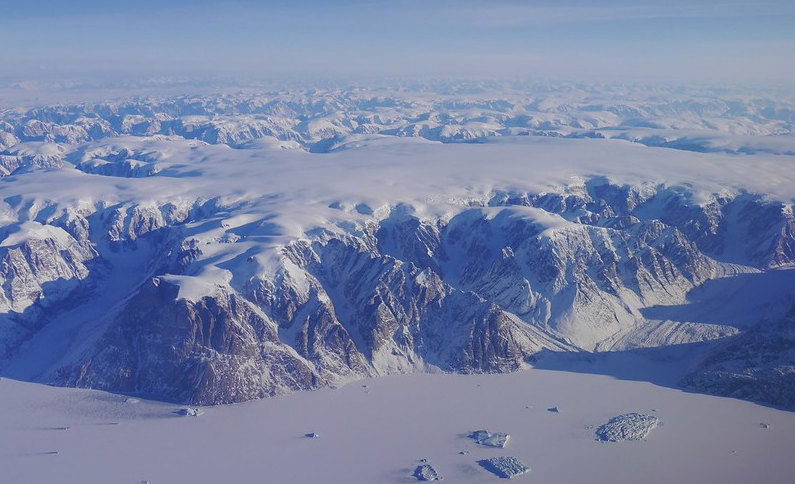OSU researcher’s study of Greenland ice core data offers insight into climate ‘tipping points’ during the last Ice Age

CORVALLIS, Ore. (KTVZ) – A changing climate triggers a sudden shift in ocean circulation, creating weather havoc and plunging Earth into an abrupt new Ice Age.
It sounds like the basis for a Hollywood blockbuster - the 2004 science fiction disaster film “The Day After Tomorrow,” has similar plot lines – but it’s actually a scenario that played out multiple times during the last Ice Age, which ended more than 11,000 years ago.
Just-published research from multiple ice cores collected across Greenland, with data spanning up to 120,000 years, provides new understanding of these abrupt events, how they unfold and what that might mean for the future.
The events, known as Dansgaard-Oeschger events, represent “tipping points” in Earth’s climate – situations in which the climate crosses a threshold that leads to sudden and large-scale change, said the study’s lead author, Christo Buizert, an associate professor in the College of Earth, Ocean, and Atmospheric Sciences at Oregon State University.
“It is really important to understand such tipping points in the climate, because they may result in catastrophic and irreversible change,” he said.
The findings were just published in the Proceedings of the National Academy of Sciences.
The Dansgaard-Oeschger cycle, which occurred more than 25 times during the last Ice Age, according to previous research, is caused by rapid on-off switching of the Atlantic Meridional Overturning Circulation, or AMOC, which circulates water throughout the Atlantic Ocean. The powerful Gulf Stream, which carries warm tropical waters to the North Atlantic, is part of the AMOC.
“The AMOC is fundamentally unstable, and when it collapses, big things happen across the globe. There is significant cooling in Europe and around the North Atlantic, and the Indian and Asian monsoons fail,” Buizert said. “That instability was frequent during the last Ice Age. It is cause for concern for the future because climate models suggest the AMOC will likely weaken again under global warming, potentially impacting billions of people.”
Buizert is a paleoclimatologist who uses ice cores to reconstruct and understand past climate change. Scientists drill and collect ice cores in Greenland and Antarctica to analyze the water, dust and tiny air bubbles that have been trapped in the ice over time. Data from ice cores provides important records of Earth’s atmospheric changes over hundreds of thousands of years and have served as pillars for scientists’ understanding of past climate events.
Buizert and his colleague analyzed ice cores from across Greenland, including cores from south and coastal east Greenland that had not previously been studied in detail, to better understand the climate impact of Dansgaard-Oeschger events across the continent.
The new data, coupled with new climate modeling, suggests interactions between the AMOC and wintertime sea ice play a key role in the Dansgaard-Oeschger events. Scientists previously thought sea ice from the Nordic Seas north of Iceland was involved in these events, but the researchers’ new analysis suggests that winter sea ice would have extended much farther south, to 40 degrees latitude. This means the sea ice would have reached modern day France and New York City, where the action also took place in the film, “The Day After Tomorrow.”
“The model shows that the Nordic Seas alone wouldn’t be big enough to drive a climate change event of this size,” Buizert said. “It just doesn’t pack enough of a punch.”
The AMOC has been well-behaved over the last 11,700 years, but current climate conditions and climate modeling suggest it will likely weaken again in the future, though for different reasons than occurred in the last Ice Age, Buizert said.
“We know the AMOC will weaken, but will it collapse? That is the big question. The weakening is likely gradual for the time being, but it could cross a tipping point and become a catalyst for abrupt climate change events like we saw in the past,” he said. “The climate does not behave in linear patterns; it can change quickly and irreversibly.”
The research was supported by the National Science Foundation and done in collaboration with scientists from five countries. Drilling of the Renland ice core in eastern Greenland was led by the University of Copenhagen, Denmark.
About the OSU College of Earth, Ocean, and Atmospheric Sciences (CEOAS): The college is renowned for research excellence and academic programs that span the earth, ocean and climate sciences, as well as the human dimensions of environmental change. CEOAS inspires scientific solutions for Oregon and the world.